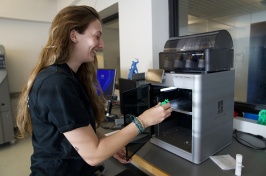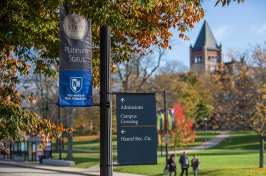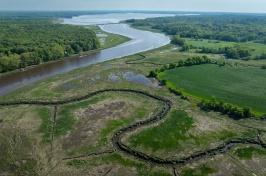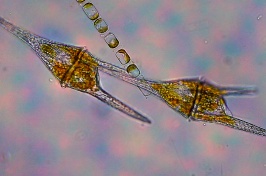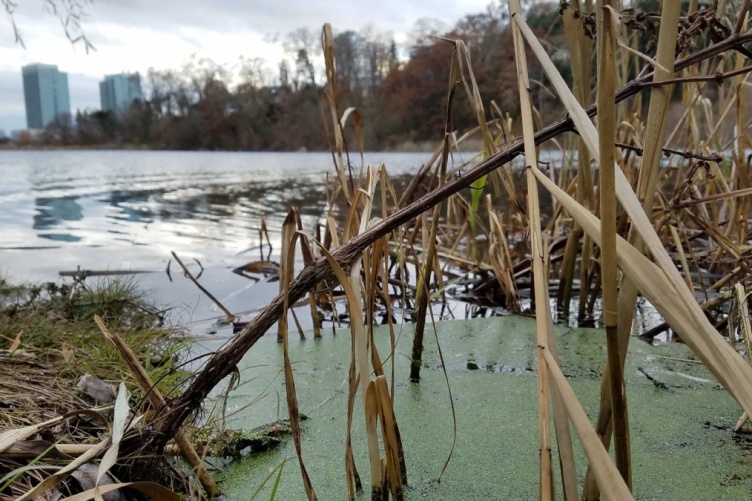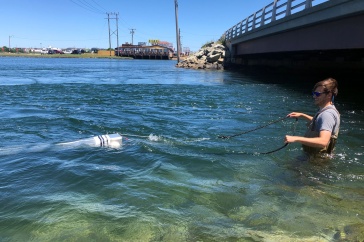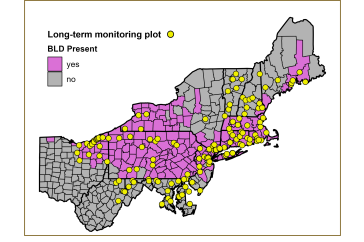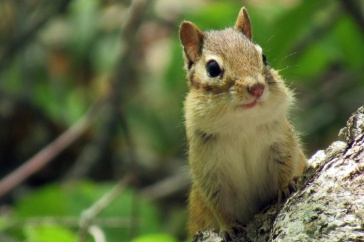Tiny aquatic plants called duckweed, and the microbes that live on and inside them, could one day be artificially engineered to improve cleansing chemicals from urban and agricultural environments in water that runs off into retention ponds and other stormwater. That’s a focus of research led by Anna O'Brien at the University of New Hampshire’s College of Life Sciences and Agriculture.
O’Brien, who is also a scientist with the New Hampshire Agricultural Experiment Station (NHAES), has spent her career studying plants and their relation to the microbial organisms that live on or inside them, as well as how this microbiome reacts to environmental stressors such as pollution. At UNH, she’s particularly interested in common duckweed (species in the genus Lemna), aquatic plants found in ponds, lakes and slow-moving streams across the world, including New Hampshire and northeast New England.
“Duckweed is an ideal plant to study and consider for applied uses because it grows rapidly and easily, and is abundant and widespread,” said O’Brien, an assistant professor in the department of molecular, cellular and biomedical sciences.
“By understanding and harnessing the natural diversity of these plant-microbe systems, we can improve the design and efficiency of constructed wetlands, ultimately contributing to the health and sustainability of freshwater ecosystems.” ~ Anna O'Brien, assistant professor in the department of Molecular, Cellular, and Biomedical Sciences
Some of O’Brien’s research has centered on duckweed’s bioremediation capabilities— the plant’s ability to remove contaminants from water. As part of a study featured in the NHAES's INSPIRED Water Quality and Management issue, O’Brien constructed thousands of small test duckweed environments meant to mimic larger environments—and their microbiomes—by collecting plant and water samples from 50 different sites that varied in their level of urbanization. These plant–microbiome combinations were observed after adding mixtures of road salt and benzotriazole, a chemical used to inhibit corrosion of certain metals and found frequently in urban runoff. Upon entering soil and water, the slowly degrading benzotriazole could adversely impact plant growth and animals, particularly fish.
“Our goal was to understand how the benzotriazole and salt impacted the duckweed–microbiome systems,” said O’Brien. “What we found was that the duckweed–microbiome mixtures could transform this chemical into byproducts predicted to be less toxic, even in the high-salt conditions that are often typical of regional urban runoff.”
According to O’Brien, this information can inform municipal planners, natural resource managers and non-profit organization professionals in developing targeted wetlands for stormwater management.
“By understanding and harnessing the natural diversity of these plant-microbe systems, we can improve the design and efficiency of constructed wetlands, ultimately contributing to the health and sustainability of freshwater ecosystems,” added O’Brien.
O’Brien and her team are now investigating the use of duckweed as a natural soil additive, particularly within agricultural environments, to help lessen reliance on and reduce nutrient runoff from chemical fertilizers.
You can read about this study and related research in the INSPIRED Water Quality and Management research report. The INSPIRED research report is produced by the New Hampshire Agricultural Experiment Station.
This project was funded by NSERC Discovery Grants, a University of Toronto XSeed Grant, NSERC Canada Research Chair program grants, and a Gordon and Betty Moore Foundation grant.
-
Written By:
Nicholas Gosling '06 | COLSA/NH Agricultural Experiment Station | nicholas.gosling@unh.edu
















